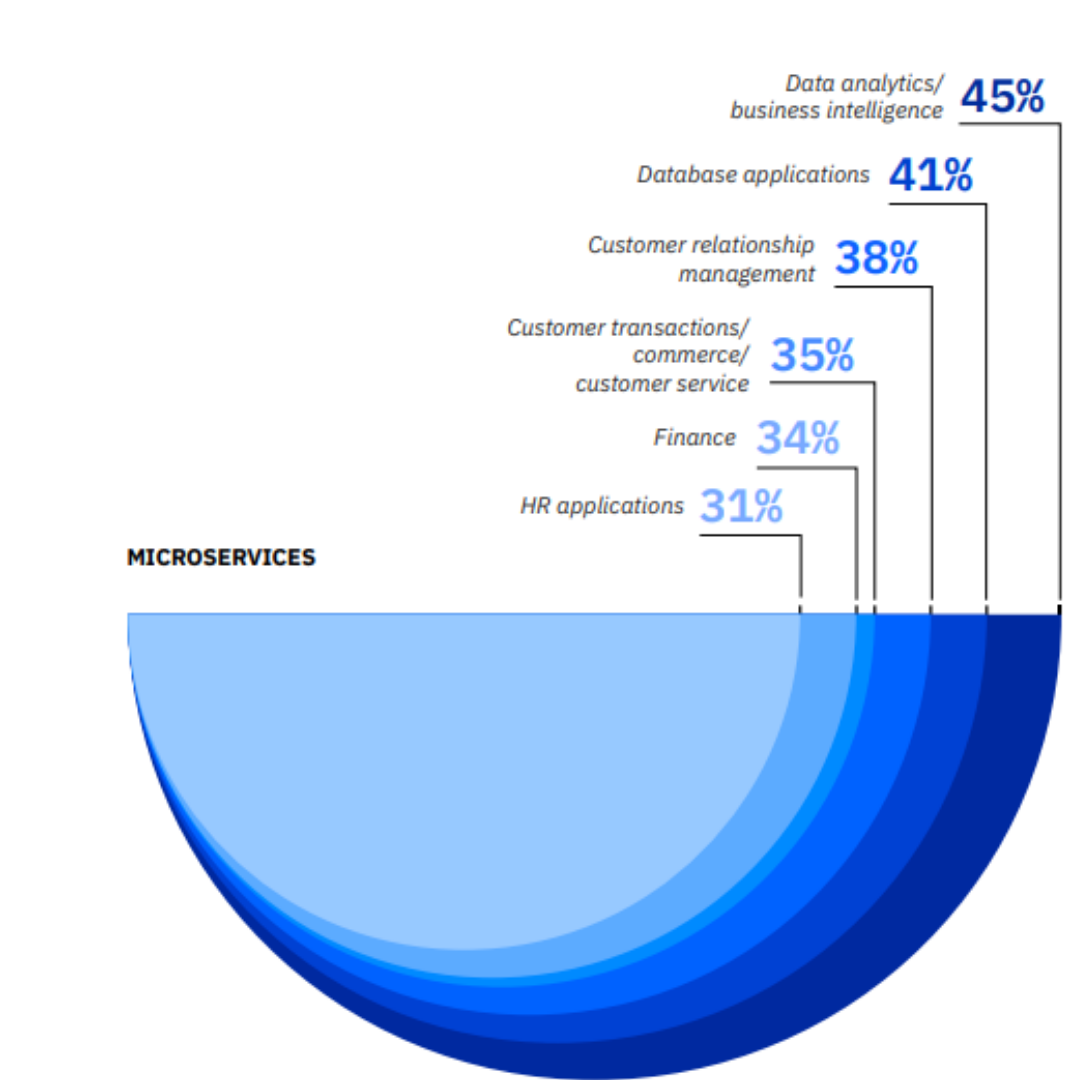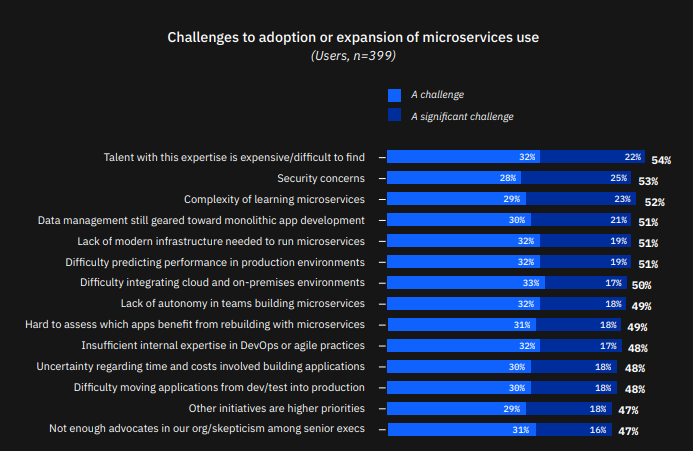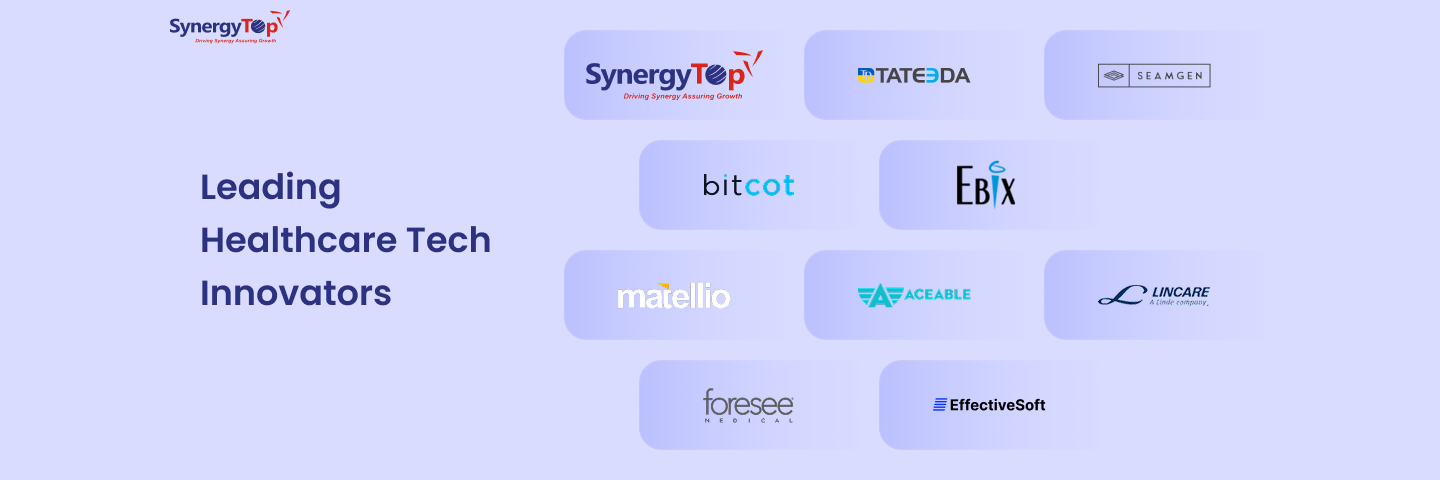According to data from Allied Market Research, the microservices architecture market was valued at $2,073 million in 2018.
And it’s expected to grow at a CAGR of 18.6% between 2019 and 2023 and reach $8,073 by the end of the forecast period.
Further, there are more than a dozen active use cases of microservices architecture in various domains. Some of them are:

This makes it clear that microservices architecture is gaining significant traction and attracting a lot of attention in the software development industry.
- But what is microservices architecture?
- What are the benefits of a microservices architecture that are drawing the software development industry towards it?
- And more importantly, how can you leverage the benefits of microservices architecture for your software development needs?
Find answers to all these questions in this blog right here!
What is microservices architecture?
Microservices architecture is a method of software development that involves breaking down applications into small, independent services that work together. With its fragmented approach, microservices architecture offers many advantages compared to traditional systems that are built as a single, large piece.

These microservices are like puzzle pieces that can be developed, deployed, and expanded individually.
But they can communicate with each other through clear rules. Thus, allowing organizations to create powerful and scalable software solutions.
A great example of an organization that switched from a monolithic architecture to microservices is Amazon.
Driving A Revolution With Microservices – The Amazon Story
In 2001, Amazon stood tall as a monolithic powerhouse, reshaping the retail landscape.
Fast forward to 2021, and the world had become intimately acquainted with Amazon Web Services (AWS) – an ingenious in-house solution that evolved into a game-changing cloud computing service.
The remarkable transformation of Amazon serves as a resounding testament to the immense power of microservices.
Microservices, with their inherent agility and versatility, proved to be the catalyst that propelled Amazon to unprecedented heights. By seamlessly tracking user behavior, purchases, and even the entire sales funnel, these finely-grained components unleashed a torrent of invaluable data, enabling Amazon to optimize product presentation and revolutionize the sales process itself.
The paradigm shift instigated by microservices was nothing short of extraordinary. Amazon’s journey showcases the undeniable potential of this groundbreaking approach, which not only spurred their own success but holds the promise of transforming businesses of all scales.
Now, let’s explore the benefits of microservices architecture and find out why it has become so widely embraced in the software development community.
The Benefits of Microservices Architecture
1. Agility and Scalability
- Microservices architecture allows different services to be developed and deployed independently.
- This enables faster development cycles, as different teams can work on different services concurrently without dependencies.
- With microservices, it is easier to scale specific components of an application based on demand.
- So instead of scaling the entire monolithic system, individual services can be scaled independently. Hence optimizing resource utilization and reducing costs.
- Microservices promote a DevOps culture by facilitating continuous integration and deployment.
- With that, updates and bug fixes can be rolled out to specific services without affecting the entire application. Thus, ensuring quick and seamless delivery.
2. Fault Isolation and Resilience
- In a microservices architecture, each service operates independently.
- That’s why a single bug or failure cannot bring down the entire application. This leads to increased fault tolerance and availability.
- By distributing the application’s functionality across multiple services, microservices architecture provides inherent redundancy.
- This means that if one service becomes unavailable, the other services can still operate. Thus, reducing downtime and increasing resilience.
- Microservices architecture enables granular monitoring and error handling at the service level.
- Developers can easily identify and isolate issues within specific services. This leads to faster troubleshooting and improved system reliability.
3. Technology Diversity and Flexibility
- Microservices architecture allows organizations to use different technologies for different services, based on their specific requirements.
- This flexibility enables developers to choose the most suitable tools and frameworks for each service. Ultimately, optimizing performance and productivity.
- With microservices, organizations can adopt new technologies and update individual services without affecting the entire system.
- This flexibility enables the adoption of emerging technologies. It facilitates the implementation of innovative features. And promotes the evolution of the software solution over time.
- Microservices promote modular design, allowing services to be reused across different applications and projects.
- This reduces duplication of efforts, enhances code maintainability, and accelerates future development.
4. Team Autonomy and Collaboration
- Microservices architecture aligns well with agile methodologies. That’s because it promotes small, autonomous teams responsible for individual services.
- This decentralized ownership empowers teams to make decisions quickly, iterate rapidly, and take ownership of their services’ lifecycle.
- Microservices architecture encourages cross-functional collaboration between teams.
- Since services communicate through well-defined APIs, teams can work independently on their services while ensuring seamless integration with other components.
- Microservices enable teams to experiment with new ideas and innovate more effectively.
- Independent services can be developed, tested, and deployed quickly. Thus, fostering a culture of continuous improvement and innovation.
5. Scalable and Resilient Infrastructure
- Microservices architecture is well-suited for cloud-native deployments.
- Services can be deployed on containers or serverless platforms, leveraging the scalability, flexibility, and fault tolerance provided by cloud infrastructure.
- Microservices architecture enables efficient load balancing and horizontal scaling at the service level.
- Services experiencing high traffic can be scaled independently, ensuring optimal performance and responsiveness.
- With microservices, organizations can optimize resource allocation by assigning specific resources to individual services based on their requirements.
- This leads to improved resource utilization and cost efficiency.
Leveraging The Benefits Of Microservices Architecture For Your Software Development Needs
Microservices architecture offers numerous benefits for software development. However, it is also plagued by several challenges.
Some of the challenges identified in a survey include:

Now a majority of these challenges can be easily mitigated with the support of an expert software development company with expertise in microservices architecture.
Further, it is crucial to partner with a proficient software development firm experienced in implementing and managing microservices-based systems to effectively leverage the advantages of microservices architecture.
Choosing the right development partner can enable businesses to harness the full potential of microservices and drive innovation in the rapidly evolving digital landscape.
At SynergyTop, we have a team of solution architects and product engineers who can design, develop, and deploy your software/application using a microservices architecture. Our team’s hands-on experience helps bypass routine challenges and even tackle unique roadblocks.
To explore how we can help you leverage microservices architecture for your software development needs, schedule a free initial consultation with our experts today.
















